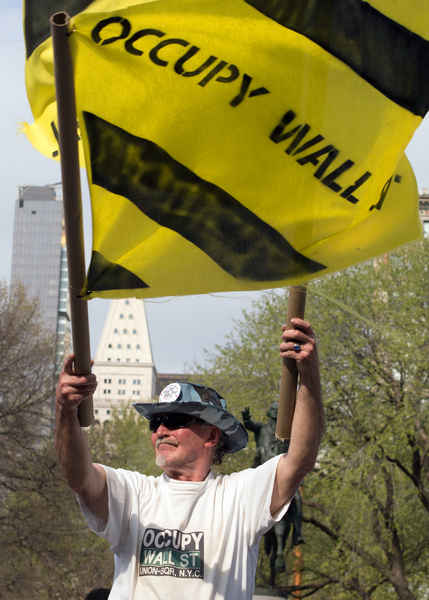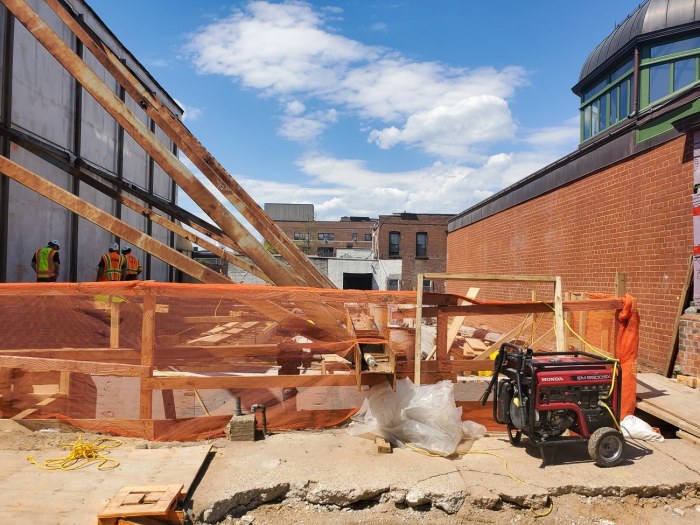BY ZACH WILLIAMS | I arrived in Zuccotti Park in early October last year with a plan similar to the activists I came to chronicle. I’d show up, see what happened and go from there. It seemed too much was happening in the present to worry about the future.
With a backpack of gear and 40 pounds of food, I began a half-year spent observing the progress and development of Occupy Wall Street in Lower Manhattan.
Media reports often focused on the sensational. Marches and confrontations with police were the most prominent aspects of the movement the media followed. But behind the public image of a movement composed of incredibly diverse causes was always an underlying mission. For six months now, the movement has often been described as a potentially powerful populist movement still lacking the cohesion necessary to drive concrete, political change.

That characterization remains prominent as the movement emerges from three months of relative calm. But while the crowds got smaller during the winter months, the movement has nonetheless grown more sophisticated and organized. There is talk of staging an “American Spring.” As the recent arrests of some 70 activists in the early hours on Sunday, March 18 have demonstrated, the protests, occupations, marches and arrests will continue. New Yorkers should expect to see more of O.W.S. in the coming months.
So then, what is it that they want?
They certainly believe in the value of discussion, as evidenced by the leaderless nature of the movement and its reliance on consensus building. Simply put, they just want people to show up.
While the movement clearly envisions a more progressive America, it won’t be issuing specific policy prescriptions anytime soon. Rather, the whole point of the movement has been to create a forum for public discourse outside the current political framework our society has come to consider the norm. If members of “the 99 percent” engage in a collective discussion, where the exchange of ideas is not corrupted by outside influences such as corporate interests, a more equitable and just society would emerge, so they proclaim.
It’s a very anarchist ideology for a movement with few actual anarchists. It relies on the assumption that the political and economic elite in this country has gained undue influence on society at large. If average people would “occupy,” then democratic consensus could be reached on crafting solutions to the wide range of economic, political and social issues facing and threatening contemporary America.
According to the First Amendment, all Americans have the right to free speech and the right to assemble. Last September 17, a small group of activists exercised these rights by camping out in Zuccotti Park. Their presence soon evoked questions as to whether they had a legal right to dominate the use of a privately owned, public space to host an open encampment. What were they doing there except standing around, protesting for a bunch of leftist causes and making a mess?
The question remains as relevant now as it was then. They were hoping people would keep coming, that their movement would effectively become a meeting place for all Americans who felt that something had to be done to ensure that everyone had their fair shake in this country.
They were talking about how to make a better world as much this week as the first night I slept in the park. For those who have not followed the movement closely, it’s important to note how it has become more difficult for critics to characterize now, than in the first weeks of the occupation. When I arrived, there were no tents -— just rows and rows of people in sleeping bags. Tents only became the defining feature in the park after the freak snowstorm in late October.
People spent most of their time ‘protesting,’ discussing their backgrounds and the reasons why they felt developments in our country were so disturbing that they had to come to Lower Manhattan to express their concerns. Campaign finance reform, bank bailouts, the wars in Iraq and Afghanistan, corporate regulation and financial reform were five of the activists’ most common talking points.
Some were unemployed college graduates, while others were well into middle age with jobs flexible enough that they could get away for a few days. Most were financially struggling for one reason or another. A few were quite wealthy and had the appropriate camping gear for the endeavor. It was a great variety of people that held up the cornucopia of signs that surrounded the park, trying to entice passersby into a conversation.
But the variety of causes represented by such a motley crew of Americans had mixed success in inspiring more of the “99 percent” to become involved. At its height, the Zuccotti Park encampment had about 500 regular residents. Crowds at some of the largest marches hovered around 10,000 people. Just as the movement was making inroads into the national political discourse, a new image of O.W.S. was forming.
As soon as people get privacy, they start doing things they don’t want others to see. The encampment in Zuccotti Park was one of the last major occupations nationwide to erect tents. While the shelter was necessary to protect protesters from the elements, it also made their movement vulnerable to caricatures.
Since the beginning, some opponents of the movement sought to label the protestors as left-wing radicals with unbecoming personal habits. Yes, they had a right to free speech, said the critics, but their assembly was beyond control. When the tents came up, their charges gained a certain amount of legitimacy. Many people outside the movement saw them less as idealists and more as a scraggy bunch of neo-hippies more inclined to mischief than to serious political activism.
With the tents came the pot smoking. Shortly thereafter, the drug dealers moved in. I never saw any use of hard drugs within the park. Perhaps it happened, perhaps it didn’t. What I did see, though, was the growing presence of the hangers-on who changed the character of the movement.
Many of them came for the free food, the free lodging, and simply for something to do as they continued their wayward lives. They were the type of characters one would see on Telegraph Avenue in Berkeley, California: prone to dreadlocks, snarky in nature, drifting and a bit dirty from spending too many nights outside. Chronically homeless people came with mental problems while drunken characters disrupted the sleep of activists late into the night. Reports of rapes circulated.
Many wondered if O.W.S. would survive the winter. Some within the movement lamented the costs associated with providing social services to people who were not “real occupiers.”
Then on November 17, the movement changed dramatically once again. The NYPD raid that day relieved organizers of the trouble of managing the park. But the lack of a central space would define the movement in the three months that followed.
Organizing continued. Most of the hangers-on stopped coming to O.W.S. events as money grew tight and fewer resources were made available to them. New alliances were struck with outside groups aimed at increasing the crowds come spring. Occasional marches and events drew a few hundred here, maybe a few thousand there. But the movement lacked the visibility offered by the park. Now with springtime upon us, it will be interesting to see what direction the movement will go.
Critics will continue to charge that the movement lacks specific demands and focus and thus cannot be taken seriously. There will be reports on how the movement has evolved since last autumn for better or worse. Some will say the national movement is gaining traction among everyday Americans, while others will contend that O.W.S. is going nowhere.
But little, in fact, has changed. The movement will continue to be defined by who shows up. Ignoring it will not mean it will simply disappear. Whether it succeeds in mobilizing larger crowds is only the first step, according to activists. The desired change will only materialize as a result of consensus, achieved by participants that show up and add their own ideas to the ongoing discussion.

















